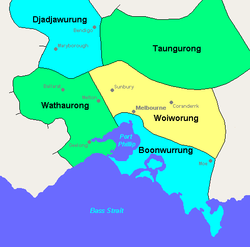Woiwurrung
Before colonisation, they lived predominantly as aquaculturists, swidden agriculturists (growing grasslands by fire-stick farming to create fenceless herbivore grazing,[1] garden-farming murnong yam roots and various tuber lilies as major forms of starch and carbohydrates[2]), and hunters and gatherers.
The Woiwurrung tribes would have been aware of the Europeans, through the close relationship to the Boon wurrung people of the coast who came into contact with the Baudin expedition on the French ship Naturaliste during 1801, and then the British settlement at Sullivan Bay in 1803, near modern-day Sorrento, Victoria.
William Buckley, a convict, escaped from this abortive settlement and lived for more than 30 years with the Wathaurong people before approaching John Batman's party in 1835.
He told George Langhorne in 1836: I frequently entertained them (the Wada wurrung), when sitting around the campfires, with accounts of the English People, Houses, Ships – great guns etc.
James Fleming, one of the party of Charles Grimes in HMS Cumberland who explored the Maribyrnong River and the Yarra River as far as Dights Falls in February 1803 reported smallpox scars on several Aboriginal people he met, indicating that a smallpox epidemic had swept through the tribes around Port Philip before 1803 reducing the population.
[12] The Wurundjeri incorporated these epidemics in their oral tradition as the Mindi, a rainbow serpent from the Northwest sent to destroy or afflict any people for bad deeds, hissing and spreading white particles from its mouth from which disease could be inhaled.
I have no doubt that, in generations gone by, there has been an awful plague of cholera or black fever, and that the wind at the time, or some other appearance from the north-west has given rise to this strange being.
[13]On 6 June 1835 John Batman met with eight elders of the Woiwurrung people including Bebejan and Billibellary, the traditional owners of the lands around the Yarra River.
The meeting took place on the bank of a small stream, likely to be the Merri Creek and treaty documents were signed along with exchanges of goods by both sides.
[14] For a purchase price including tomahawks, knives, scissors, flannel jackets, red shirts and a yearly tribute of similar items, Batman obtained about 200,000 hectares (2,000 km2) around the Yarra River and Corio Bay.
[18] Derrimut, an arweet of the Boon wurrung informed the early European settlers in October 1835 of an impending attack by "up-country people".
[23] The Woiwurrung and Boon Wurrong people bore the brunt of the effects of British settlement in the Foundation of Melbourne from 1835 onwards, with the population declining rapidly.
[b][25] On the instructions of Charles La Trobe, a Native Police Corps was established and underwritten by the government in 1842 in the hope of civilising the Aboriginal men.
Despite numerous petitions, letters, and delegations to the Colonial and Federal Government, the grant of this land in compensation for the country lost was refused.
Communities consisted of six or more (depending on the extent of the territory) land-owning groups called clans that spoke a related language and were connected through cultural and mutual interests, totems, trading initiatives and marriage ties.
It is generally considered that before European settlement, six separate clans existed: When foreign people passed through or were invited onto Woiwurrung lands the ceremony of Tanderrum – freedom of the bush – would be performed.
This continues for hours and the natives never seem to tire of the exercise.The game was a favourite of the Woiwurrung clans and two teams were sometimes based on the traditional totemic moieties of Bunjil (eagle) and Waang (crow) of the Kulin people.
[30] There are a number of significant sites, in particular those found near the Yarra & Maribyrnong Rivers and the Merri Creek, where corroborees were held between clans and perhaps neighbouring territories to share in music and dance, exchange news and trade.








